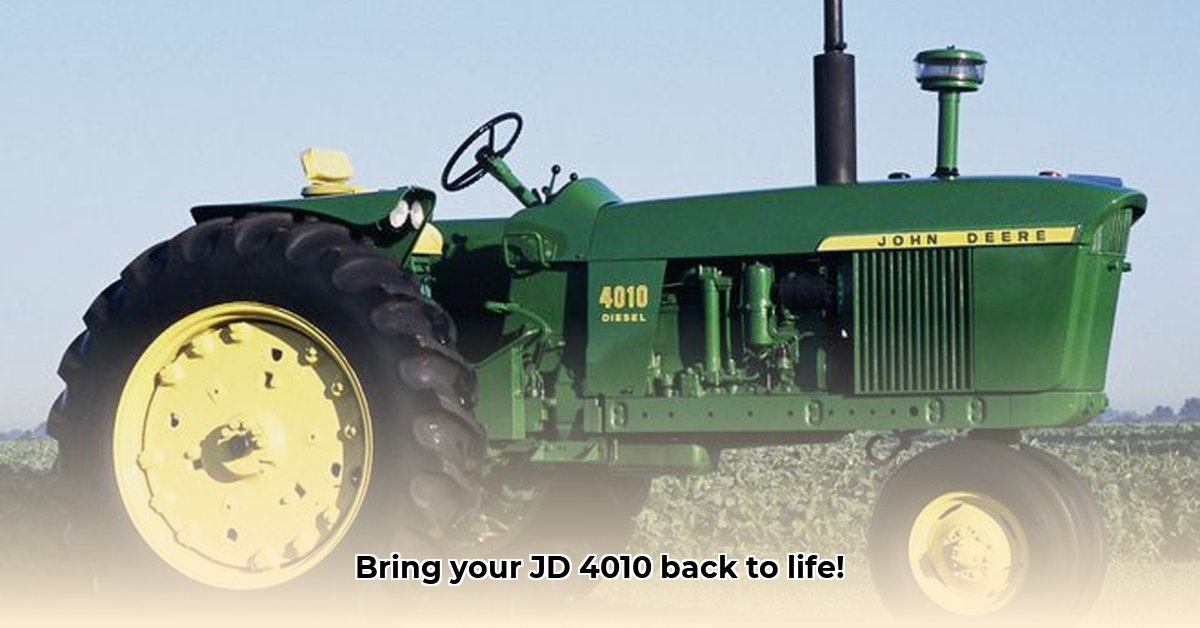
Getting Started: Understanding Your JD 4010
Before you begin the restoration of your John Deere 4010 tractor, understanding its specific configuration is crucial. JD 4010s varied considerably in engine type (gasoline, diesel, LPG), transmission, and other features impacting your restoration strategy. Did you know the 4010 was produced from 1963 to 1971, a testament to its robust design? Consult your owner's manual and the tractor's serial number plate to accurately identify your model. Online resources like TractorData can further assist in this identification process. This initial step is critical for identifying correct replacement parts. What specific details will you need to determine first? For additional resources, check out this helpful JD 4010 guide.
Assessing Your Tractor: A Comprehensive Inspection
A thorough assessment lays the groundwork for successful restoration. Think of this as a pre-surgery examination for your tractor to gauge the extent of the work needed.
Parts Inventory: Carefully examine each component, noting its condition (good, repairable, or beyond repair). Create a detailed list of all parts, including those missing. This list forms your restoration shopping list. How can you ensure accuracy in this initial inventory?
Visual Documentation: Photograph the tractor extensively before disassembly. These serve as your restoration roadmap and records of the tractor's original state. Remembering the details is often difficult: how can you preserve visual memory?
Mechanical Check-Up: Inspect the engine, transmission, hydraulics, and electrical system for damage, leaks, cracks, and rust. Addressing issues early prevents larger problems down the line. What are some key warning signs to look out for during this inspection?
Disassembly: A Methodical Approach
Disassembly requires patience and a systematic approach. Safety is paramount.
Safety First: Always disconnect the battery before work. Wear appropriate safety gear (gloves, eye protection, safety shoes) – safety is not optional. How can you create a safe workspace for disassembly?
Systematic Removal: Remove easily accessible components first (seat, fenders, etc.) to avoid accidental damage. A logical approach prevents confusion during reassembly.
Meticulous Organization: Label each component and securely store screws, bolts, and nuts in labeled containers. How can you effectively organize your labeled components throughout disassembly?
Continued Documentation: Take photos at every step of disassembly. These photos aid reassembly and serve as a valuable record of your progress.
Cleaning, Repair, and Replacement: Revitalizing Your Tractor
With your tractor disassembled, focus on cleaning and repairs.
Thorough Cleaning: Remove grease, dirt, and rust using appropriate solvents and brushes. This isn't just about aesthetics; a clean base allows for accurate assessments. What cleaning solutions are best suited for restoring your JD 4010?
Component Evaluation: Inspect each part, determining its condition (repair or replace). Avoid shortcuts. What criteria should guide your decision to repair or replace parts?
Engine Overhaul (Conditional): Engine work may require specialized knowledge or professional help if you're inexperienced. Is engine overhaul always necessary for a full restoration?
Transmission Inspection: Similar to the engine, a transmission overhaul might be required. What signs indicate the need for a transmission overhaul?
Parts Acquisition: Original JD parts are ideal, but aftermarket suppliers, salvage yards, and fabrication may be necessary. How can you ensure the quality of aftermarket or fabricated parts?
Reassembly: Reconstructing Your JD 4010
Reassembly is the reverse of disassembly, but requires precision.
Reverse Order: Follow your photographs and reassemble in reverse order of disassembly. How can you minimize errors during the reassembly process?
Torque Specifications: Use a torque wrench to tighten bolts to manufacturer specifications. Why is using a torque wrench crucial?
Proper Lubrication: Generously lubricate all moving parts to extend their life and ensure efficiency. What types of lubricants are best for your specific tractor components?
Wiring Integrity: Use wiring diagrams to ensure correct connections, testing components as you go. What strategies can you employ for accurate wiring?
Testing and Adjustments: Bringing Your Tractor to Life
After reassembly, testing is paramount.
Engine Start-Up: Carefully start the engine, monitoring oil pressure and temperature. What are the critical parameters you should monitor during the initial start-up?
Fluid Level Checks: Check all fluid levels (oil, coolant, hydraulic fluid). How frequently should you check fluid levels?
Hydraulic System Test: Test the hydraulic system using implements, looking for smooth operation. What should you look for when checking the functionality of the hydraulic system?
Transmission Testing: Ensure smooth gear shifting. What are some indicators of a properly functioning transmission?
Fine-Tuning: Make necessary adjustments for optimal performance. What calibration steps are important following reassembly?
Troubleshooting Common Issues
Electrical Problems: These are often easier to diagnose than mechanical issues.
Hydraulic Leaks: Check seals and hoses for leaks.
Engine Malfunctions: May require professional help.
Transmission Problems: Require a detailed inspection, potentially requiring professional assistance.
Resources and Suppliers
Your Local John Deere Dealer: Parts and expert advice.
Online Tractor Forums: Valuable peer-to-peer support from experienced restorers.
Specialty Tractor Parts Suppliers: For hard-to-find parts.
Restoring a JD 4010 is a journey. With patience, this guide empowers you to bring your classic tractor back to its former glory. Remember, take your time, enjoy the experience, and seek help when needed.